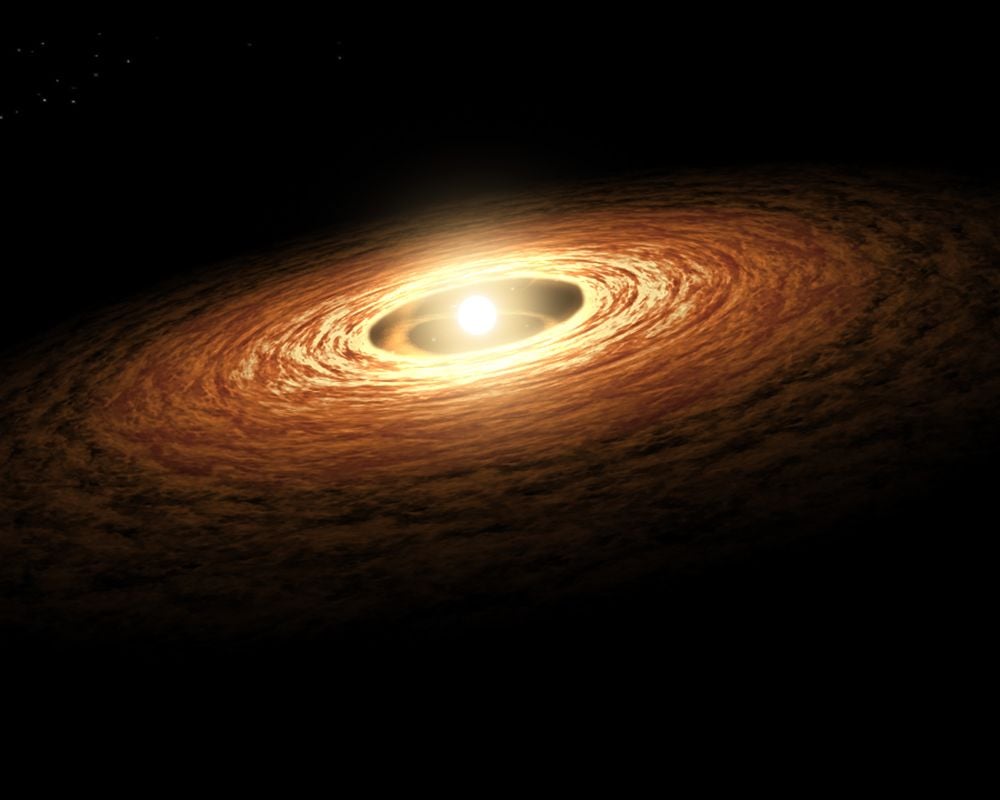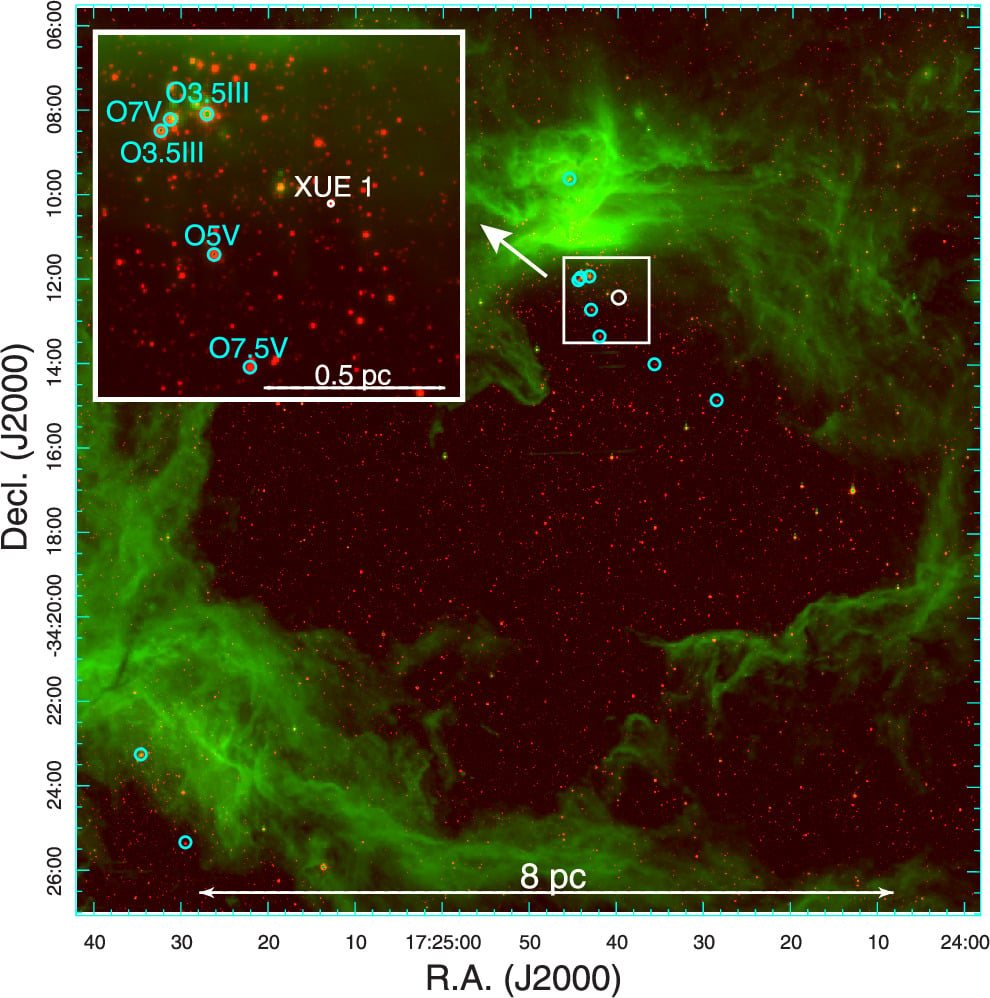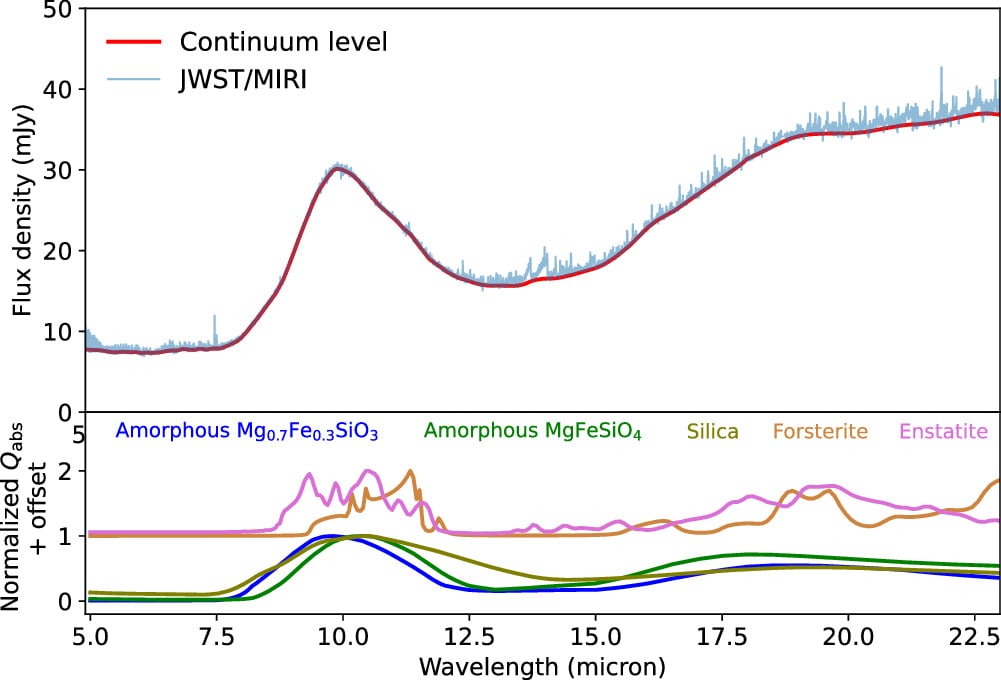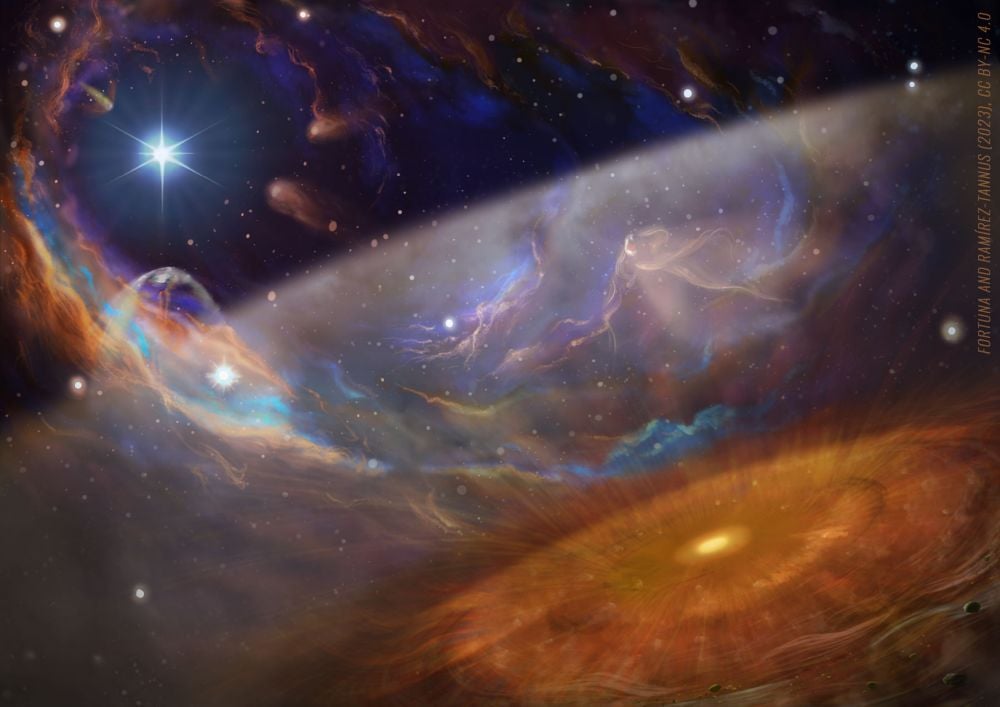We know that planets form in protoplanetary disks, swirling collections of gas and dust that rotate around very young stars. But we don't know all the details, partly because it's difficult to see inside these disks and watch the process unfold. One question astronomers want an answer to concerns ultraviolet radiation. Does extreme ultraviolet radiation disrupt the planet-forming process?
Extreme ultraviolet (EUV or XUV) radiation is defined as radiation with wavelengths between about 10 and 121 nanometers, lying between far ultraviolet and soft X-rays on the electromagnetic spectrum. Young, massive stars are copious producers of EUV and can have deleterious effects on objects nearby, including protoplanetary disks. Astronomers wonder if EUV can disrupt planetary formation in these disks, and new research aimed to find out.
The research is titled "XUE: Thermochemical Modeling Suggests a Compact and Gas-depleted Structure for a Distant, Irradiated Protoplanetary Disk." It's published in The Astrophysical Journal, and the lead author is Bayron Portilla-Revelo. Portilla-Revelo is a postdoctoral researcher in astronomy and astrophysics in the Eberly College of Science at Penn State University.
"Astronomers have long sought to understand how planets form within the swirling disks of gas and dust that encircle young stars," said Portilla-Revelo in a press release. "Protoplanetary disks often form in proximity to massive stars that emit substantial amounts of ultraviolet (UV) radiation, potentially disrupting the disks and affecting their capability to form planets."
 *This artist's impression shows a young star surrounded by its protoplanetary disks. Planet formation in these disks is a complex process, and there are many holes in our understanding of it. Image Credit: NASA/JPL*
*This artist's impression shows a young star surrounded by its protoplanetary disks. Planet formation in these disks is a complex process, and there are many holes in our understanding of it. Image Credit: NASA/JPL*
Our Sun emits UV energy, but 99% of it is blocked by Earth's atmosphere. Even the 1% that makes it through can cause cellular damage and cancer. In space, EUV radiation from massive young stars is unimpeded. How does all of that energy affect protoplanetary disks?
Researchers have made progress in understanding the planet-forming process, but there are some obstacles. Because of the obscuring dust, these disks can be difficult to observe, so most observations have been limited to relatively nearby disks. Unfortunately, these nearby disks aren't near the types of young stellar systems where massive young stars emit EUV. "While significant progress has been made by studying protoplanetary disks in nearby star-forming regions, these regions lack the intense UV radiation present in more massive and common stellar nurseries," Portilla-Revelo said.
"Unveiling the physical structure of protoplanetary disks is crucial for interpreting the diversity of the exoplanet population," the authors write in their paper. "Until recently, the census of the physical properties of protoplanetary disks probed by mid-infrared observations was limited to the solar neighbourhood." Unfortunately, there are no O-type stars in the neighbourhood.
Fortunately, astronomers now have the JWST. "The James Webb Space Telescope (JWST) now enables observations of disks in distant high-mass SFRs, where strong external far-ultraviolet radiation is expected to impact those disks," the authors explain.
The researchers used the space telescope to examine a young star about 5,500 light-years away in NGC 6357, also known as the Lobster Nebula. This area is also home to more than 20 massive stars that emit powerful EUV energy. Two of the stars are among the most massive in the Milky Way. This is a nearly ideal region to study the effects of EUV on planet-forming disks.
The work focuses on a solar-mass star named XUE 1 and its protoplanetary disk. XUE 1 is part of the young stellar cluster named Pismis 24, which is inside the NGC 6357 star-forming region. Luminous O-type stars emitting EUV are only about one light-year away.
 *This image shows XUE 1 and its neighbours in the Pismis 24 cluster. The blue circles show O-type stars, powerful emitters of disruptive EUV radiation. Image Credit: Portilla-Revelo et al. 2025. ApJ*
*This image shows XUE 1 and its neighbours in the Pismis 24 cluster. The blue circles show O-type stars, powerful emitters of disruptive EUV radiation. Image Credit: Portilla-Revelo et al. 2025. ApJ*
The disk is bombarded with EUV from its more massive neighbours. Using JWST observations and astrochemical models, the researchers identified dust grains in the disk that will eventually form planets. According to their analysis, there's enough to create 10 Mercury-mass planets.
 *This figure shows some of the dust found in XUE 1's disk. The bottom panel shows absorption efficiency curves for some dust species. They describe how effectively dust grains absorb electromagnetic radiation as a function of wavelength. They help researchers understand the disk's dust properties and how it will evolve. Image Credit: Portilla-Revelo et al. 2025. ApJ*
*This figure shows some of the dust found in XUE 1's disk. The bottom panel shows absorption efficiency curves for some dust species. They describe how effectively dust grains absorb electromagnetic radiation as a function of wavelength. They help researchers understand the disk's dust properties and how it will evolve. Image Credit: Portilla-Revelo et al. 2025. ApJ*
They also found water vapour, carbon monoxide, carbon dioxide, hydrogen cyanide, and acetylene molecules. While these molecules were previously detected in the disk, the researchers were able to determine how they are distributed in it.
These molecules are expected to contribute to the formation of the atmospheres of emerging planets," said study co-author Konstantin Getman. Getman is a research professor in the Department of Astronomy and Astrophysics at Penn State. "The detection of such reservoirs of dust and gas suggests that the fundamental building blocks for planet formation can exist even in environments with extreme ultraviolet radiation.
While the building blocks for planets appear to remain intact, the nearby O-type stars and their powerful XUV radiation are still shaping the disk. Specific molecules, like cyanogen (CN) and polycyclic aromatic hydrocarbons (PAH), are used as tracers for UV irradiation. The researchers found no evidence of these molecules and inferred that XUE 1's disk is compact and stripped of gas by XUV in its outer regions. The disk extends for only about 10 AU, or about the distance to Saturn in our Solar System.
Our results imply that dust and gas material can be present within the first 10 au in a strongly irradiated disk," the authors write in their conclusion. "This supports the idea that planet formation is possible even in environments with extreme UV irradiation.
These findings support the idea that planets form around stars even when the natal disk is exposed to strong external radiation," said study co-author Eric Feigelson, professor of astronomy and astrophysics and statistics at Penn State. "This helps explain why astronomers are finding that planetary systems are very common around other stars.
The authors mention one caveat in their work. XUE 1's disk structure aligns with a scenario where EUV has photoevaporated gas in the disk's outer regions. However, due to "model degeneracies," the disk could be more massive and less photoevaporated.
"Observing and characterizing a population of highly irradiated disks will help to break this degeneracy," they conclude.
Press Release:Unveiling the secrets of planet formation in environments of high UV radiation
 Universe Today
Universe Today
